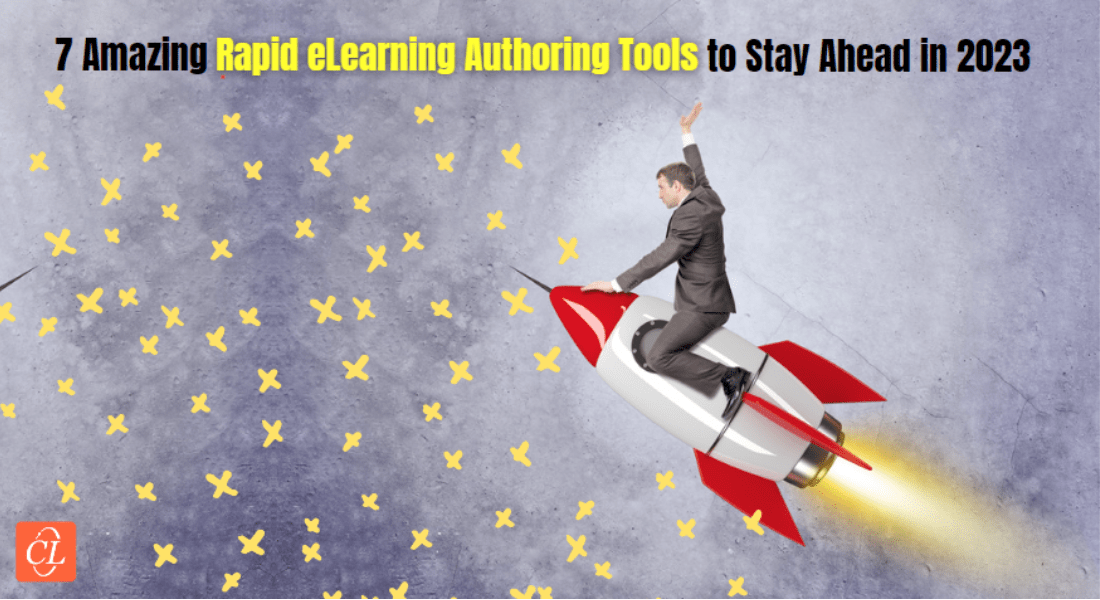The 5 Best eLearning Authoring Tools and Software in 2022

Corporate training has evolved in the last decade following the emergence of digital learning. During the COVID-19 pandemic, organizations were switching from traditional instructor-led classroom training to eLearning courses and virtual sessions. If you’re planning to transform your training strategy with a cost-effective digital course to upskill your employees, you need to get the basics right. Start by choosing a powerful eLearning authoring tool or software.
In this post, we’ll talk about eLearning authoring tools in detail, including factors to consider when picking the best one. We’ll also break down the five best authoring tools in the market, analyzing pros, cons, and main selling points of each tool to help speed up your decision-making process.
Let’s get started!
Are you looking forward to selecting an authoring tool that’s just right for you?
Here are our top 5 picks:
- Articulate Storyline 360
- Lectora
- iSpring Suite Max
- domiKnow One
- Adobe Captivate
What is an eLearning Authoring Tool?
An eLearning authoring tool is a software solution used to develop a corporate training course from smaller portions of content, such as text, images, audio clips, and videos. These innovative tools help managers and course developers glue various chunks of information together and maximize them by using unique features such as gamification, animation, and simulation to boost interaction and engagement.
Authoring tools also allow developers to package content in a format that can easily be integrated into existing LMS (Learning management system) or shared via the internet on multiple platforms – HTML5. This also reduces the need to install a software to access the course. Learners can easily use web browsers on any device to access their courses and begin their training.
How to Choose an eLearning Authoring Tool?
Considering the abundance of options in the market, organizations must do their homework when selecting the best authoring tool for eLearning course design and development. Here are the main factors to consider before choosing a specific tool or software:
Type of Training Content
The first thing you need to determine is the type of training content you want to use to upskill your employees. Are you looking to use software simulations, interactive text, quizzes, short video lessons, or all of these and more? Not all authoring tools have a one-size-fits-all. Some might not offer the features you’re looking for, while others might offer a lot more than what is required.
Cross-Platform/Device Compatibility
Next, you need to determine how well the tool works on different browsers and devices to ensure it facilitates your learners’ preferences and habits. Previous generations might have had no problem taking courses from their workstations at work.
However, today’s workforce, which typically includes Millennials and Gen Zees, wants to be able to access training material from anywhere and at any time. Therefore, your authoring tool and eLearning course should be a 100% mobile compatible to ensure your content is responsive on desktops, smartphones, and tablets.
Budget
While you shouldn’t choose authoring tools and solutions based on the price, it is important to set aside an annual corporate training budget so that you can manage your expenses. Grabbing the cheapest option could turn out to be counter-productive in terms of functionality and accessibility. Ideally, you should aim for a solution offering the best value for your money.
Benefits of eLearning Authoring Software
Before we choose among the best authoring tools, here are some of the main benefits of this trending mechanism:
Faster Course Development
The most significant benefit authoring tools offer organizations is the shorter hours of course development thanks to built-in templates, themes, and other visual content. This way, you don’t have to spend time downloading or creating custom media and creating layouts from scratch.
Easier Updates and Revisions
Authoring tools allow users to make quick revisions and updates to existing course content. This way, organizations can keep up with the latest developments and practices in their respective industries and pass that knowledge on to their staff.
Enhanced Learner Participation and Engagement
Authoring tools allow you to create better learning experiences for your employees in terms of accessibility, tailored content, and bite-sized information. Consequently, learners find it more engaging and actively participate in training to further improve their skills and productivity.
The Best eLearning Authoring Tools and Software in 2022 – Our Top 5 Picks
Now that you’re aware of the key benefits of authoring tools, here are our top 5 picks from the market:
1. Articulate Storyline 360
Articulate Storyline 360 is Articulate’s flagship authoring tool designed for users that use Microsoft Powerpoint but want more features. Storyline 360 is one of the most popular tools for organizations in the eLearning design community that are looking for customized training content. However, it’s not the best choice as it doesn’t have any built-in templates, making it difficult for newbie developersto create them from scratch.
Nevertheless, there is a huge collection of custom course templates, characters, buttons, and backgrounds in Storyline 360’s content library for fast paced instructional design. However, this tool requires time spent in learning to design and develop eLearning courses. Training managers and course developers look for standard assessment tools which they can find when using the Articulate QuizMaker to create multiple-choice questions, fill-in-the-blanks, and hotspots, just to name a few.
Pros
- Offers a sense of familiarity to Microsoft PowerPoint users due to its similar interface
- More options for customization
- Screen recording and editing functionality
- Content library with stock images
- You can import PowerPoint files
Cons
- You can find tools with a more user-friendly interface
- It takes a lot of RAM and processing power
- Not available for MAC
2. Lectora
Lectora is a powerful cloud-based learning management solution and authoring tool that provides businesses with the platform to design and publish corporate training courses. Since it’s a web-based solution, it can be accessed using any browser on any device. One of the best features of Lectora is that it offers great Getting Started templates for beginners with built-in navigation, page layouts, and instructions.
Compared to many other tools, Lectora has a learning curve that is not too challenging. However, its menu system and layout can be confusing at first. As far as assessments go, Lectora lets users build quizzes and surveys with its vast selection of question types, including multiple-choice, true-false, rank-in-order, and drag-and-drop.
Pros
- WCAG Compliant
- Custom scripts, fonts, CSS, and quiz options
- A library filled with stock images for faster development
- Conditional branching is supported
Cons
- More expensive than others
- Subpar UI experience
- Requires a lot of editing to create responsive courses
3. iSpring Suite Max
iSpring Suite Max is a feature-packed authoring tool designed to help organizations enable their rapid eLearning course design and development. This powerful tool works as a PowerPoint add-in, which in turn gives users, who are accustomed to PPTs, a sense of familiarity.
iSpring can help you can optimize your existing content with stunning features, such as videos, screencasts, conversation simulations as well as quizzes.
Thanks to its seamless integration with PowerPoint, iSpring is quick and easy to use when compared to other tools in the market. However, by exploring its modules and features, you can create both simple and complex interactions for slide-based courses. Another great feature of iSpring is its 100% mobile-ready content as it is enabled by HTML5.
With this feature, you don’t need separate versions of the software for mobile-friendly and desktop courses. iSpring offers several publishing options such as MP4 and SCORM.
Pros
- Use PPT files as your starting point
- Quicker learning with simple UI interface
- Built-in dialogue simulator for conversations and narrations
- Text-to-speech functionality
- Over 68,000 digital assets, including templates, icons, and backgrounds
Cons
- Requires PowerPoint for it to work
- No support for software simulation
- Only works on Windows devices
4. domiKnow One
domiKnow One is another popular authoring tool that managers and course developers can use to create different types of training content for mobile devices. Due to its responsive design, content is simplified for publishing and sharing. Moreover, everything is in one place, which makes it better for teams to collaborate on.
domiKnow One offers an integrated authoring platform that allows creators to efficiently cultivate better learning experiences. From formal training courses to microlearning modules and video simulations, the users’ options are unlimited. This platform is one of the easiest authoring tools to use for sustained benefits.
Pros
- Excellent for collaborating with teams and sharing progress
- Easy revisions and updates
- Excellent customer service and real-time support
- Easy accessibility on any browser and device, including MAC
Cons
- Some tools and features, such as simulation, take time to learn
- Some users claim the container resizing option doesn’t work
- Users need to always stay connected to the internet
5. Adobe Captivate
Adobe Captivate is one of the fastest-growing authoring tools in the market. Itis well suited for eLearning course design and development. Using this tool, you can create quizzes, simple slide presentations, and complex interactive courses. Moreover, considering the popularity of Adobe, Captivate is the go-to solution for many developers looking to create real-life simulations and Virtual Reality projects using HD videos and screen content.
HCaptivate is an advanced solution, so you need to be prepared to spend a lot of time understanding its functions. Captivate offers 19 interactive templates, including industry favorites like “Who wants to be a millionaire?” and “Scrabble.” Perhaps, the best feature Adobe Captivate offers is its built-in editor with which you can create videos.
Pros
- 360-degree (VR) virtual reality capability
- An asset library packed with thousands of templates and characters
- Has a separate version for MAC
- Text-to-speech functionality
- Offers simulation recording feature
Cons
- Subpar user interface
- A steep learning curve
- Prone to crashing on Windows
- Outsourced technical support
The Bottom Line
And there you have it – the best eLearning authoring tools and software in 2022 for all your corporate training needs. With this information, you’re on track to finding the best solution that’s right for you. Of course, there are several other popular options in the market that you could choose from. However, our top 5 picks have dominated the market ever since their arrival and each one offers unique benefits for course developers and training managers.
Are you eager to gain more insights into how you can choose the right authoring tool? Here’s a comprehensive guide to help you decide the best tool for your eLearning course design and development.





